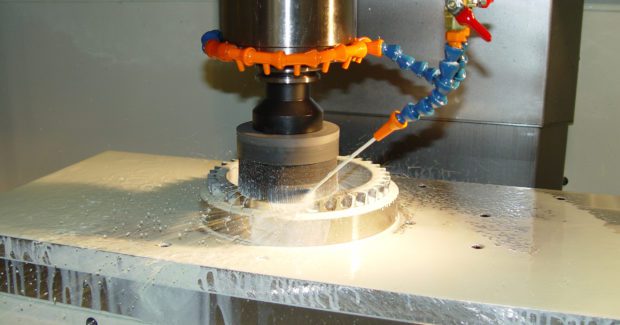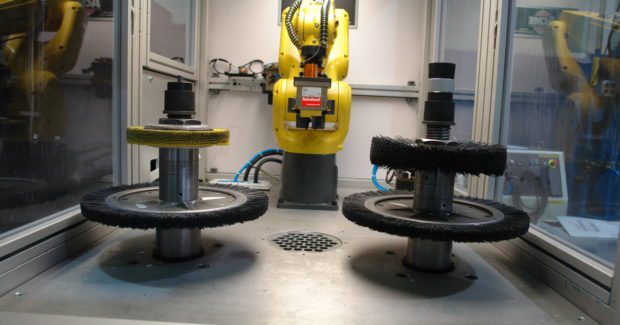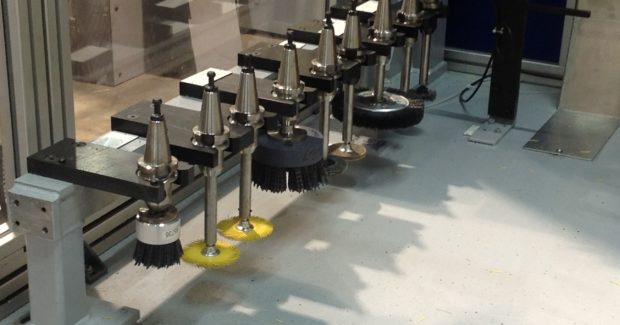Automated Deburring of Mission-Critical Parts
Burrs cannot be part of the equation in mission-critical part applications. Here are some ways to switch from manual to automated deburring to improve part-to-part consistency and quality, produce more parts per shifts and increase uptime, and reduce labor costs and time lost to operator injuries.
Posted: May 9, 2016
Whether it is landing gear, turbine engine blades or the fuel body, aerospace parts require tight tolerances and adherence to strict specifications, given that failure in a finished part can be catastrophic. When manufacturing these mission-critical parts and others for the aerospace industry, deburring is a necessary step in the process. Another challenge in producing these sorts of aerospace parts is the type of material that is typically used, such as Inconel, titanium or super alloy powdered metals. These high-end, high-nickel alloy products tend to be much tougher, increasing the challenge to properly deburr the part without damaging it.
To remove burrs and sharp edges on parts that have been machined, shops now have multiple options. For many years, manual deburring processes were the most widely used. But today, with advances in both CNC machining centers (up to 60,000 rpm) and cutter technology (coatings), burrs created by machining are smaller and more manageable. This allows more opportunities for automation of the process, including deburring the part while it is still in a CNC machining center, or using dedicated custom-built deburring machines (typically in high volumes), or with robotic cells. Custom-designed robotic deburr cells typically offer the most flexibility because they can manipulate either deburr tool and media or the part being deburred. However, all of these methods offer similar benefits, including improved consistency and quality in the finished part, greater productivity, and reduced fatigue and repetitive motion for operators.
One important result of automated deburring is that it will identify any upstream process variations that may exist. Unlike manual deburring, a robotic system cannot tell that a dull cutter needs changing, which can result in larger burrs being left on the part. Automated deburr processes are typically developed around a specific batch of parts from one production run. If the burr’s root thickness at the point of attachment changes substantially after that, the process is no longer capable of removing the larger burr. If the process is adjusted to accommodate the larger burr, it may “over break” parts on the next production run when new tooling has been introduced. Shops should consider setting a maximum number of parts their tooling is to run and automatically change the tools when that number is reached.
https://youtu.be/GjbXiwmpIo8
MORE MEDIA OPTIONS
Robotic deburring offers a much wider selection of compliant devices, especially compared to a CNC machining center. They can be used in conjunction with a force torque sensor, commercial compliant devices and tools, or with custom-made pneumatic slides. This means more media options with much higher aggressions are available, including brushes, non-woven abrasives, coated abrasives, bonded abrasives and even small carbide cutters. Typically CNC machines must rely on the compliance of the media, which limits media selection to mainly brushes and some non-wovens with less aggression.
The ability to choose from many different types of media and tool sizes can provide greater aggression in the deburring process, for a better finish and better – and often faster – results. For example, choosing a sharper grain type such as ceramic over aluminum oxide results in more aggressive cutting action. Almost all abrasive types today offer some form of ceramic grain. Coated abrasive belts and discs, mounted points, brushes and so forth all utilize the sharp, more friable ceramic grains resulting in much higher cut rates than in the past.
When selecting media, keep in mind that larger is always better in regards to cycle time and media life. Selecting a larger brush, for example, provides an improved cutting action by providing more abrasive grains. If every filament has grain and every grain is a “cutter,” then having a brush with more filaments provides more cutters. Brush aggression is directly related to the brush ID circumference, which controls the amount of filaments a brush can have. In robotic deburr cells it is very common to have 12 in or 14 in diameter media, while in CNCs 5 in (125 mm) media is usually the maximum.
IMPROVED CYCLE TIMES
Automated deburring typically provides cycle times that are half or less of those needed to manually deburr the same part. In one example, a manufacturer of a large turbine blisk was able to reduce the deburring time from nine hours manually to less than two hours in a robotic deburr system. This offers benefits for productivity and throughput, as well as savings in labor hours – all while typically improving part consistency or quality.
PART FIXTURING
A robotic deburring process can automatically pick up a part, deburr one side, then set the part down in a re-grip station and pick the part back up to expose the opposite side for deburring. This capability results in a much faster process versus CNC, where an operator may be required to move the part to various fixtures – a process that may take a number of part movements which add cost to the part, but not value. When deburring large parts, a robot carries a tool with its media, rather than the part itself. Since most deburr processes do not generate the pressure of the machining processes, the fixtures do not need to be as rigid, leaving much more part exposure for media access compared to deburring in a CNC.
BATCH PROCESSING CAPABILITIES
With the automated re-gripping capabilities of a robotic deburring system, batch processing is very common in regards to part flow. This allows for more parts to flow through the machine faster since a tray of six, 12 or 20, for example, can be loaded into the cell for unattended deburring. In a CNC system a pallet may hold multiple parts, but they still must be manually moved to multiple positions. Automated deburring systems can also be built to accommodate single-piece part flow as well, if that is the preference for the application.
ADDITIONAL FACTORS
Besides the benefits outlined above, there are some other factors to keep in mind when considering a change from manual to automated deburring in aerospace manufacturing:
- Footprint: The footprint of the system is typically larger with automated deburring. A manual deburring process may occur at a small work station or bench, while the smallest robotic systems are generally 5 ft by 6 ft – with some much larger in size. Be sure to consider the space requirements of a robotic system’s footprint when laying out the process floor plan. In regards to dust collection in an automated system, save space by integrating it into the cell’s enclosure framework, adding it to the roof structure or tying it to an existing central dust collection system.
- Cost: An automated process offers obvious benefits for part consistency and quality and process throughput, but it also requires an investment. Factors to consider include the cost of the automated deburr equipment and the plant startup expenses. Compare those to potential savings, which include decreased quality control rejections and component rework; improved component consistency and uniformity and overall production; reduced media costs and labor requirements; and protective equipment savings. Weigh the return on investment that can be achieved through improved part quality, a reduction in wasted parts and materials, and labor savings due to a faster process, and consider if those are in line with the priorities and needs of the manufacturing operation.
EFFECTIVE RESULTS WITH AUTOMATED DEBURRING
In mission-critical aerospace applications, burrs cannot be part of the equation. Part manufacturers can gain significant benefits by implementing an automated deburring process. A switch from manual to automated deburring can improve part-to-part consistency and quality, produce more parts per shifts and increase uptime, and reduce labor costs and time lost to operator injuries. An automated process offers more aggressive deburring action, accuracy and speed – for an optimized manufacturing process.







